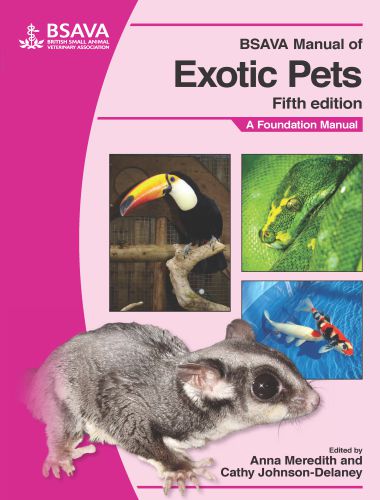Manual of Exotic Pets – A Foundation Manual 5th Edition by Anna Meredith, Cathy Johnson Delaney May 2010, This remains the Foundation Manual for information across the range of exotic pets, from small mammals, through birds, reptiles and amphibians, to invertebrates. Commoner pets, such as rabbits, rodents and budgies retain their place.
Manual of Exotic Pets – A Foundation Manual 5th Edition

However, the ever-increasing range of non-traditional pets encountered by the veterinary surgeon in practice is reflected in coverage of some new groups, such as marsupials, ratites and crocodilians.
The best-selling Manual of Exotic Pets has been a ‘must-have’ text for so many clinicians since the first edition was published in 1991. Since then veterinary knowledge of, and exposure to, exotic pets has increased greatly, and this new updated edition reflects this. Looking back and comparing the first edition to this new one, the progress, expansion and development in the field has been vast.
This Manual of Exotic Pets – A Foundation Manual 5th Edition includes some new species (otters, skunks, marsupials, ratites) while other species now have expanded stand-alone chapters (e.g. African pygmy hedgehogs, axolotls and salamanders). One species (fancy pigs) has been moved entirely to the Manual of Farm Pets.
The main aim of the Manual is to provide clinicians with easy access to necessary information in a standardized format for each chapter and species. The chapters are set out to lead the clinician from the natural history of a species, through the anatomy and physiology, husbandry, housing, dietary requirements, handling and restraint, diagnostic approach and major common conditions. Each chapter has tables of information providing quick access to biological data, blood work, common diseases and drug formularies so that a problem-oriented system approach can be carried out.
The authors and editors recognize that, as exotic pet medicine evolves, this Manual can no longer cover all species in sufficient depth, and so many chapters refer to the clinician to other Manuals that provide more detailed information. This Foundation Manual can thus be seen as a starting point, designed to provide busy practitioners with a quick guide and the basic knowledge that enables them to deal professionally with a particular species even if it is unfamiliar. Password: PDFlibrary.Net
| PDF Size: 30 MB | Go Book Download |

“pdflibrary.net” is wrong file password for download.